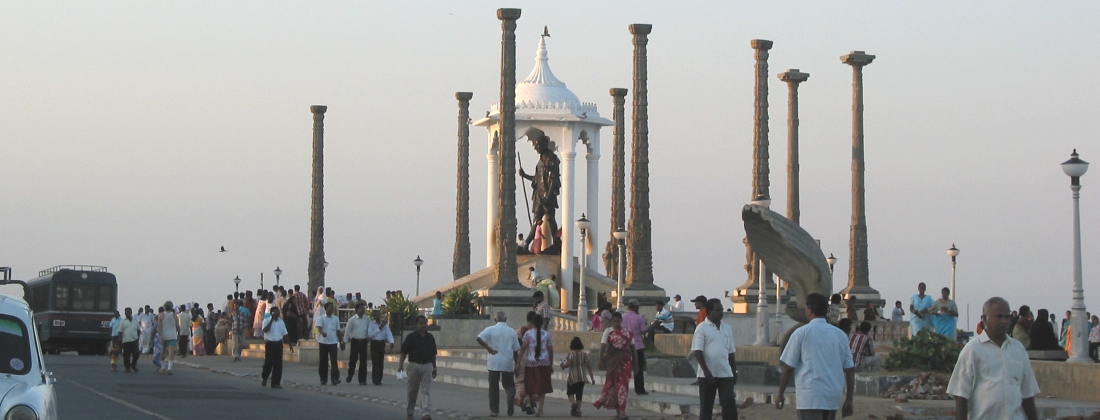
Excursions and Local Getaways
Shorter outings and trips in the area around Auroville
Many guests in Auroville also want to explore and familiarize themselves with the region in which the Auroville project is located. We therefore offer several options for shorter outings and trips in the surrounding area, giving you insight into the cultural and geographical features of a fascinating land. Experience the local wildlife, soak up the atmosphere inside traditional Hindu temples, visit important churches and places of pilgrimage, explore historic town districts and enjoy the beauty of the local landscape.
… in the vicinity of Auroville
On request, we happily arrange a guided day excursion to Puducherry for you. The city, located in the immediate vicinity of Auroville, looks back on a rich history, marked by more than 300 years of French colonial rule.
In the historic colonial district, running up to and along the waterfront,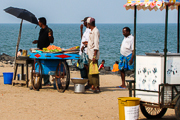 Puducherry presents a unique atmosphere that has preserved its French past. Local attractions include former colonial villas, several Catholic churches, the spaciously arranged Bharati Park, the Sri Aurobindo Ashram and the Sri Manakula Vinayaka temple. On the waterfront, the “French quarter” is flanked by a 1.5 km long beach boulevard, the city’s main promenade. In the middle of this promenade, encircled within a pavilion with eight antique granite pillars, stands a four-meter high statue of Gandhi. Among the historic buildings along the beach promenade are the old lighthouse, the old customs house and the old town hall, the latter being a protected monument.
Puducherry presents a unique atmosphere that has preserved its French past. Local attractions include former colonial villas, several Catholic churches, the spaciously arranged Bharati Park, the Sri Aurobindo Ashram and the Sri Manakula Vinayaka temple. On the waterfront, the “French quarter” is flanked by a 1.5 km long beach boulevard, the city’s main promenade. In the middle of this promenade, encircled within a pavilion with eight antique granite pillars, stands a four-meter high statue of Gandhi. Among the historic buildings along the beach promenade are the old lighthouse, the old customs house and the old town hall, the latter being a protected monument.
The main building of the Sri Aurobindo Ashram, founded in 1926, is open for visitors from 8am to 12pm and from 2pm to 6pm. The “heart” of the Ashram is the samadhi in the central courtyard, the flower-covered tombs of Sri Aurobindo and his spiritual companion, called “The Mother” by her followers. Unlike other ashrams, the Sri Aurobindo Ashram is not distinctly separated from its surrounding area, but extends to more than 400 buildings, spread out over the former French colonial quarter. In addition to schools, hospitals and libraries, the ashram also comprises many businesses and shops.
Several interesting churches testify to Puducherry’s colonial past. 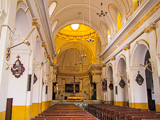 The largest is the Basilica of the Sacred Heart (Sacré Coeur), built in the Gothic Revival style, located at the southern end of the town center. Directly in the city center is the baroque Immaculate Conception Cathedral (Notre Dame de la Conception Immaculée), which is the episcopal seat of the Archdiocese of Puducherry and Cuddalore. In the former colonial district, near the beach promenade, one finds a church in Neo-Renaissance style, the church of Our Lady of Angels (Notre Dame des Anges).
The largest is the Basilica of the Sacred Heart (Sacré Coeur), built in the Gothic Revival style, located at the southern end of the town center. Directly in the city center is the baroque Immaculate Conception Cathedral (Notre Dame de la Conception Immaculée), which is the episcopal seat of the Archdiocese of Puducherry and Cuddalore. In the former colonial district, near the beach promenade, one finds a church in Neo-Renaissance style, the church of Our Lady of Angels (Notre Dame des Anges).
The oldest Hindu temple in Puducherry, the origins of which, according to tradition, date back to the 7th century AD, is the Varadaraja Perumal temple at Mahatma Gandhi Road. It is a typical example of Dravidian temple design and is dedicated to the god Vishnu. 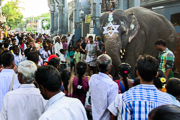 In the immediate vicinity is the Vedapureeshvarar temple, where Shiva is worshiped. The city’s most prominent Hindu temple is the Sri Manakula Vinayaka temple, which is dedicated to the elephant god Ganesha, regarded in Hinduism as the remover of obstacles and difficulties. The temple’s interior is decorated with wall paintings, representing 40 different aspects of Ganesha. A special attraction is the temple elephant Lakshmi, giving visitors her blessing at the front of the shrine.
In the immediate vicinity is the Vedapureeshvarar temple, where Shiva is worshiped. The city’s most prominent Hindu temple is the Sri Manakula Vinayaka temple, which is dedicated to the elephant god Ganesha, regarded in Hinduism as the remover of obstacles and difficulties. The temple’s interior is decorated with wall paintings, representing 40 different aspects of Ganesha. A special attraction is the temple elephant Lakshmi, giving visitors her blessing at the front of the shrine.
Also recommended is a “Heritage walk” through Eswaran Koil Street, where one can admire several historic Tamil homes.  They represent the specific characteristics of Puducherry’s early architecture, characterized by a unique blend of Tamil style elements on the ground floor and classic features of French colonial architecture on the upper floor. The architecture in the Muslim quarter, located near the main train station, is worth a visit as well. In the Puducherry Museum in the French quarter, a collection of representative stone and bronze sculptures from the Pallava and Chola periods and ancient archaeological finds from the Roman settlement of Arikamedu is on display.
They represent the specific characteristics of Puducherry’s early architecture, characterized by a unique blend of Tamil style elements on the ground floor and classic features of French colonial architecture on the upper floor. The architecture in the Muslim quarter, located near the main train station, is worth a visit as well. In the Puducherry Museum in the French quarter, a collection of representative stone and bronze sculptures from the Pallava and Chola periods and ancient archaeological finds from the Roman settlement of Arikamedu is on display.
Arikamedu, located 7 km south of Puducherry on the banks of the river Arijankuppam, is an archaeological site, serving as an important trading port during the Chola period. Arikamedu became known in the mid-20th century due to the work of the British archaeologist Mortimer Wheeler. Archaeological objects such as pottery, amphorae and glass beads indicate that there were active trade relations with Roman traders in South India more than 2000 years ago.
The town of Villianur, located 9 kilometers south of Puducherry, is a popular pilgrim and tourist destination, particularly because of the Sri Gokilambal Thirukameswarar temple. The shrine where the god Shiva is worshiped is considered the oldest, most beautiful and spacious temple in the region. The town is also known for the Our Lady of Lourdes Church.
The village of Irumbai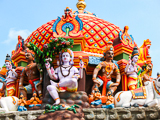 is in the immediate vicinity of Auroville. The main attraction of the village is a lovely ancient temple where the Hindu god Shiva is worshiped under the name Maakaleshvarar. An ancient legend has developed around the well-designed shrine, one that is interpreted by many residents in the area as having a reference to Auroville. It describes a festivity in this temple during which a yogi called Kaduveli Siddha was ridiculed by those present and uttered a curse to the effect that all plant life should whither, throughout the region, until in the distant future, people would come from the eight directions of the world to start planting and reforesting the area again.
is in the immediate vicinity of Auroville. The main attraction of the village is a lovely ancient temple where the Hindu god Shiva is worshiped under the name Maakaleshvarar. An ancient legend has developed around the well-designed shrine, one that is interpreted by many residents in the area as having a reference to Auroville. It describes a festivity in this temple during which a yogi called Kaduveli Siddha was ridiculed by those present and uttered a curse to the effect that all plant life should whither, throughout the region, until in the distant future, people would come from the eight directions of the world to start planting and reforesting the area again.
E-mail: insight@auroville.org.in
